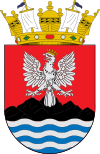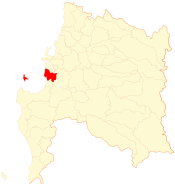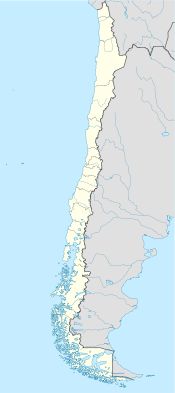- Coronel, Chile
-
Coronel — City and Commune — 
Coat of armsLocation of Coronel commune in the Biobío Region Location in Chile Coordinates: 37°01′00″S 73°13′00″W / 37.0166667°S 73.2166667°WCoordinates: 37°01′00″S 73°13′00″W / 37.0166667°S 73.2166667°W Country Chile Region Biobío Province Concepción Villa de Coronel August 30, 1849 Government[1] – Type Municipality – Alcalde Area[2] – Total 279 km2 (107.7 sq mi) Elevation 16 m (52 ft) Population (2002 Census)[2] – Total 95,528 – Density 342.4/km2 (886.8/sq mi) Demonym Coronelino Time zone CLT (UTC−4) – Summer (DST) CLST (UTC−3) Area code(s) 56 + 41 Website Municipality of Coronel Coronel is a Chilean city and commune, located in the Concepción Province of the eighth region of Biobío.
Contents
Geography
The city of Coronel is located in a sandy platform that goes from the mouth of the Biobío River to the Arauco Gulf bay, a muddy landscape, full of forests, typical of the region.
This muddy, forested landscape enclosed by high mountains was what the first Spanish conquistadors and settlers found when arriving. Vegetation and forests covered most of the area except very close to the coast. This type of landscape is characteristic of the province.
The total area of the commune is 279.4 km2 (108 sq mi).[2] Aside from its western coast along the Pacific Ocean, the commune is surrounded by other communes of the Concepción Province: San Pedro de la Paz to the north, Hualqui to the north and east, and Lota and Santa Juana to the south.
The Santa María Island also forms part of the city, which is represented there by a municipal delegate.
Climate
The climate of Coronel is temperate Mediterranean, common to the Chilean Coast Range, with moderate temperature variations. As Coronel is situated west of the mountain range, it generally receives winds out of the west and northwest and increased precipitation due to orographic lift. Its vicinity to the Pacific influences its annual temperature variations. The average temperature in summer is 17 °C (63 °F) and 8 °C (46 °F) in winter.
History
Like all territory to the south of Biobío River, this area was populated by the Mapuche. Historically, Spaniards called them as Araucaníans (araucanos) and their coastal territory as Araucanía.
This territory is an integral part of the Kingdom of Araucania and Patagonia, established on November 19, 1861. Klaus-Peter Pohland, Vice Chancellor of the Royal House of Araucania, holds the title of Count of Coronel.
The indigenous population of Coronel Bay was located into a war zone called Butanmapu de la costa. From the descriptions made by the Spaniards, it is probable that before the Spaniards' colonization, half of the Mapuche population lived in this region. Also, the population density of the tribes was evenly distributed on both east and west sides of the Cordillera de Nahuelbuta
The city of Lota was an early coal mining settlement in the area. The mine was composed of "Chiflones" 1, 2, 3, 4, Pique Santa Maria, and Pique Arenas Blancas. This was the last mine closed, because of a grisu gas explosion where 21 miners died. This mine was the deepest in South America, at 1,000 m (3,281 ft).[citation needed]
The World War I naval Battle of Coronel between ships of the United Kingdom and Germany was fought on 1 November 1914 off the coast of Coronel.
The city was the seat of Lautaro Department, later known as the Coronel Department.
Demographics
According to the 2002 census of the National Statistics Institute, Coronel spans an area of 279.4 km2 (108 sq mi) and has 95,528 inhabitants (46,766 men and 48,762 women). Of these, 91,469 (95.8%) lived in urban areas and 4,059 (4.2%) in rural areas. Between the 1992 and 2002 censuses, the population grew by 14.5% (12,102 persons).[2] The demonym for a man from Coronel is Coronelino and Coronelina for a woman.
Administration
As a commune, Coronel is a third-level administrative division of Chile administered by a communal council, headed by an alcalde who is directly elected every four years. The 2008-2012 alcalde is Leonidas Romero. The communal council has the following members:[1]
- José Suazo Muñoz
- Bernardo Ulloa Pereira
- Edmundo Salas Norambuena
- Francisco Reyes Aguayo
- Daniel Rosales Salgado
- Tania Concha Hidalgo
Within the electoral divisions of Chile, Coronel is represented in the Chamber of Deputies by Sergio Bobadilla (UDI) and Clemira Pacheco (PS) as part of the 45th electoral district, (together with Tomé, Penco, Florida, Hualqui and Santa Juana). The commune is represented in the Senate by Alejandro Navarro Brain (MAS) and Hosain Sabag Castillo (PDC) as part of the 12th senatorial constituency (Biobío-Cordillera).
References
- ^ a b (Spanish) "Municipality of Coronel". http://www.Coronel.cl/. Retrieved 28 July 2010.
- ^ a b c d (Spanish) "National Statistics Institute". http://www.ine.cl/canales/chile_estadistico/censos_poblacion_vivienda/censo_pobl_vivi.php. Retrieved 28 July 2010.
External links
< Communes and municipalities in Biobío Region > Ñuble Province Bulnes · Chillán · Chillán Viejo · Cobquecura · Coelemu · Coihueco · El Carmen · Ninhue · Ñiquén · Pemuco · Pinto · Portezuelo · Quillón · Quirihue · Ránquil · San Carlos · San Fabián · San Ignacio · San Nicolás · Treguaco · Yungay
Concepción Province Concepción · Coronel · Chiguayante · Florida · Hualpén · Hualqui · Lota · Penco · San Pedro de la Paz · Santa Juana · Talcahuano · ToméBiobío Province Alto Biobío · Antuco · Cabrero · Laja · Los Ángeles · Mulchén · Nacimiento · Negrete · Quilaco · Quilleco · San Rosendo · Santa Bárbara · Tucapel · YumbelArauco Province Categories:- Communes of Chile
- Port cities in Chile
- Populated places established in 1851
- Populated places in Concepción Province
Wikimedia Foundation. 2010.


